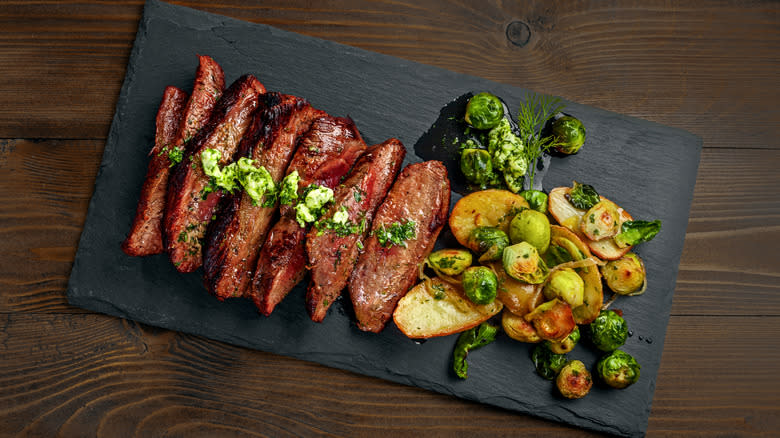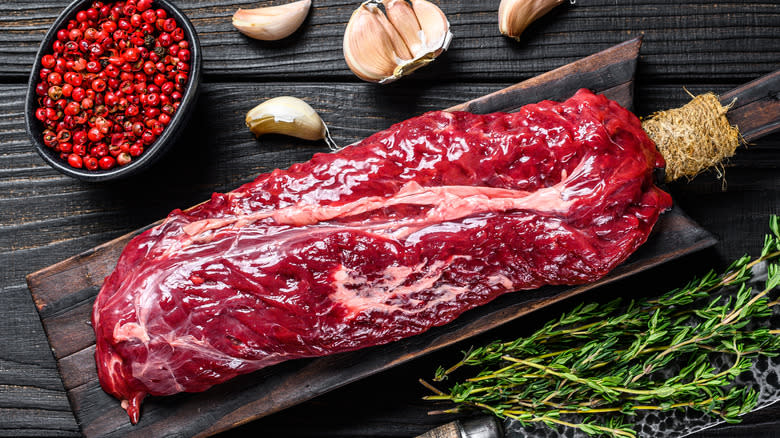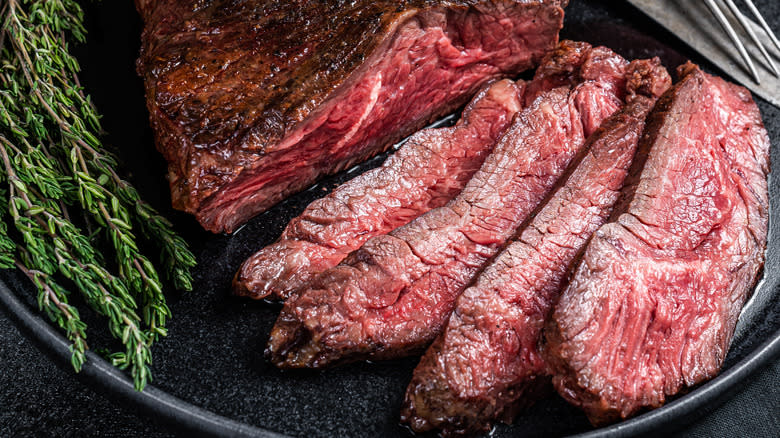Hanger Steak Is The Underrated Cut Of Beef You Should Start Using

There are all sorts of cuts of steak available on the market. Filet mignon is considered (by Gordon Ramsay at least) the "Rolls Royce of beef" for its tenderness, while ribeye is prized for its juiciness, and the flavorful New York strip that has become somewhat iconic. Heck, new steak cuts still pop up occasionally, such as flat iron steak, which was invented way more recently than you think. But there are also more established cuts that still get overlooked -- one of them is hanger steak.
If you've had a properly prepared hanger steak before, you already know this is true because this cut has no shortage of winning qualities in the flavor or texture departments. There's no mistaking a hanger steak for anything else, either visually (where its distinctive shape sets it apart) or taste-wise. You do have to be careful how you prepare it, though; while it's far more tender than its closest steak comparisons (flank and skirt steak), it can easily be overcooked -- and if you cut it wrong, its textural advantages will completely evaporate.
Read more: The 13 Best Steaks For Grilling
Hanger Steak Was Long The Prize Of Butchers

Hanger steak is indeed more popular than it once was; it shows up on restaurant menus with enough frequency that there's now debate among some chefs about whether it's overrated or underrated. But until it's widely recognized as one of the premier steak cuts, hanger steak will not have gotten its due. The hanger steak was long known as "butcher's steak" because butchers would generally keep it for themselves (a strong endorsement of its quality). Since consumers mostly ignored it, it was one of the more inexpensive cuts -- although that's not as true anymore as it grows in popularity, a problem compounded by the fact there are only two hanger steaks on any individual cow, meaning it can't be mass-marketed.
While hanger steak is a flavorful cut of beef to use in place of flank or skirt steak and has the same rich, beefy, umami flavor those bring to the table, it's distinguished from its closest comparison steaks by its more tender texture. The reason is it comes from a supporting muscle (situated between the rib and loin, hanging off of the cow's diaphragm) rather than one that gets a strong workout (as do flank and skirt). Hanger steak is also very easy to spot among the other steaks, as it has a long, thin, cylindrical shape, quite unlike most other cuts.
Cook It The Right Way To Get The Most Out Of It

You still need to be sure you're preparing hanger steak correctly, though. First, if you have it in one giant piece, you'll have to remove the sinew by slicing it down the middle (turning one steak into two in the process). Next, because it's a thinner cut, it's easy to overcook, meaning you must watch it carefully. The best temperature for hanger steak is medium rare; it can go to medium, but any more than that will toughen it, ruining its textural strengths. Cutting meat against the grain, or perpendicular to the natural muscle fibers, is generally important with beef, but it's extremely important with hanger steak, whose thick, coarse fibers will become chewy if you cut it wrong.
The best way to cook a hanger steak for maximum flavor is to cook it quickly on high heat. While marinades can be great for hanger steak, they're not as necessary here as they are with flank steak, as hanger has plenty of flavor and texture on its own. From there, it's pretty versatile, as you can serve it by itself right off the grill, slice it for use in tacos or salads, or have it on a steak sandwich. Just be sure to treat it right, and it'll treat you right in turn.
Read the original article on Daily Meal

